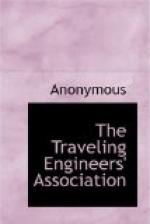154. Q. How long will the auxiliary reservoir air continue to flow to the brake cylinder?
A. Air will continue to flow to the brake cylinder until the pressure on the auxiliary side of the triple piston becomes slightly less than that on the brake pipe side, when the piston 4 and the graduating valve 7 will move to the left until the shoulder on the piston stem strikes the slide valve. (See Fig. 16.) This movement has caused the graduating valve to close the service port “Z”, thus cutting off any further flow of air from the auxiliary to the brake cylinder and also port “o”, thus preventing any further flow of air from the brake pipe to the brake cylinder. The triple valve is now said to be in lap position.
155. Q. How is the triple valve affected by a further reduction of brake pipe pressure?
[Illustration: Fig. 15. Full Service Position.]
A. A further reduction of brake pipe pressure will cause the triple piston 4 and the graduating valve 7 to again move to the right, opening ports “Z” and “o”, allowing a further flow of brake pipe and auxiliary air to the brake cylinder. This may be continued until the auxiliary reservoir and brake cylinder pressures become equal, after which any further reduction of brake pipe pressure is only a waste of air. With seventy pounds brake pipe pressure, and eight-inch piston travel, a twenty-pound reduction will cause equalization at about fifty pounds.
[Illustration: Fig. 16. Lap Position.]
156. Q. Explain the operation of the triple valve in the release of the brake.
A. To release the brakes and recharge the auxiliary reservoirs, air is admitted through the brake valve to the brake pipe. This increase of pressure on the brake pipe side of the triple valve piston 4 above that on the other side causes the piston and slide valve to move back to release position, which permits the air in the brake cylinder to flow to the atmosphere, through the exhaust port of the triple, thus releasing the brake. At the same time, air from the brake pipe flows through the feed groove “i” around the triple piston to the auxiliary reservoir, which is thus recharged. Now the “K” triple valve has two release positions: =Full Release= and =Retarded Release=. To which of these two positions the parts will move when the brakes are released, depends upon how the brake pipe pressure is increased. It is generally understood that those cars toward the head end of the train, receiving the air first, will have their brake pipe pressure raised more rapidly than those in the rear; thus the friction of the brake pipe causes the pressure to build up more rapidly in the chamber “h” of the triple valve toward the front end of the train than in those in the rear. As soon as the pressure is enough greater than the auxiliary reservoir pressure to overcome the friction of the piston, graduating valve and slide valve, all three are moved toward the left until the piston stem strikes the retarding




